Development and Application of SKSSIM Simulation Software for the Oxygen Bottom Blown Copper Smelting Process
Abstract
:1. Introduction
2. Theoretical Basis of SKSSIM
2.1. Mechanism of the SKS Process
2.2. Thermodynamic Model
2.3. Thermodynamic Data
2.4. Physical Entrainment
3. Application of SKSSIM
3.1. SKSSIM Software
3.2. Application of SKSSIM Software
3.3. Calculated Results
4. Conclusions
Acknowledgments
Author Contributions
Conflicts of Interest
References
- Coursol, P.; Mackey, P.J.; Kapusta, J.P.T.; Valencia, N.C. Energy consumption in copper smelting: A new Asian horse in the race. JOM 2015, 67, 1066–1074. [Google Scholar] [CrossRef]
- Wang, Q.M.; Guo, X.Y.; Tian, Q.H.; Chen, M.; Zhao, B.J. Reaction mechanism and distribution behavior of arsenic in the bottom blown copper smelting process. Metals 2017, 7, 302. [Google Scholar] [CrossRef]
- Li, W.F.; Zhan, J.; Fan, Y.Q.; Wei, C.; Zhang, C.F.; Hwang, J.Y. Research and industrial application of a process for direct reduction of molten high-lead smelting slag. JOM 2017, 69, 784–789. [Google Scholar] [CrossRef]
- Chen, L.; Hao, Z.D.; Yang, T.Z.; Liu, W.F.; Zhang, D.C.; Zhang, L.; Bin, S.; Bin, W.D. A comparison study of the oxygen-rich side blow furnace and the oxygen-rich bottom blow furnace for liquid high lead slag reduction. JOM 2015, 67, 1123–1129. [Google Scholar] [CrossRef]
- Liu, W.F.; Yang, T.Z.; Zhang, D.C.; Chen, L.; Liu, Y.F. A new pyrometallurgical process for producing antimony white from by-product of lead smelting. JOM 2014, 66, 1694–1700. [Google Scholar] [CrossRef]
- Qu, S.L.; Dong, Z.Q.; Chen, T. Distribution of minor elements in complex copper concentrates in oxygen-enriched bottom blown smelting process. China Nonferrous Metall. 2016, 3, 22–24. [Google Scholar]
- Shui, L.; Cui, Z.X.; Ma, X.D.; Rhamdhani, M.A.; Nguyen, A.V.; Zhao, B.J. Mixing phenomena in a bottom blown copper smelter: A water model study. Metall. Mater. Trans. B 2015, 46, 1218–1225. [Google Scholar] [CrossRef]
- Shui, L.; Cui, Z.X.; Ma, X.D.; Rhamdhani, M.A.; Nguyen, A.V.; Zhao, B.J. Understanding of bath surface wave in bottom blown copper smelting furnace. Metall. Mater. Trans. B 2016, 47, 135–144. [Google Scholar] [CrossRef]
- Zhang, Z.Y.; Chen, Z.; Yan, H.J.; Liu, F.K.; Liu, L.; Cui, Z.X.; Shen, D.B. Numerical simulation of gas-liquid multi-phase flows in oxygen enriched bottom-blown furnace. Chin. J. Nonferrous Met. 2012, 22, 1826–1834. (In Chinese) [Google Scholar]
- Yan, H.J.; Liu, F.K.; Zhang, Z.Y.; Gao, Q.; Liu, L.; Cui, Z.X.; Shen, D.B. Influence of lance arrangement on bottom-blowing bath smelting process. Chin. J. Nonferrous Met. 2012, 22, 2393–2400. (In Chinese) [Google Scholar]
- Wang, Q.M.; Guo, X.Y.; Tian, Q.H. Copper smelting mechanism in oxygen bottom-blown furnace. Trans. Nonferrous Met. Soc. China 2017, 27, 946–953. [Google Scholar] [CrossRef]
- Néron, A.; Lantagne, G.; Marcos, B. Computation of complex and constrained equilibria by minimization of the Gibbs free energy. Chem. Eng. Sci. 2012, 82, 260–271. [Google Scholar] [CrossRef]
- Rossi, C.; Filho, L.C.; Guirardello, R. Gibbs free energy minimization for the calculation of chemical and phase equilibrium using linear programming. Fluid. Phase. Equilibr. 2009, 278, 117–128. [Google Scholar] [CrossRef]
- Wu, W. Mathematical Model Research and System Development of Multiphase Equilibrium in Copper Flash Smelting. Master’s Thesis, Jiangxi University of Science and Technology, Ganzhou, China, June 2007. [Google Scholar]
- Shimpo, R.; Goto, S.; Ogawa, O. An improved computer program for equilibrium calculations. Metall. Trans. A 1993, 24, 1882–1889. [Google Scholar] [CrossRef]
- Tan, P.; Zhang, C. Computer model of copper smelting process and distribution behaviors of accessory elements. J. Cent. South Univ. Technol. 1997, 4, 36–41. [Google Scholar] [CrossRef]
- Chaubal, P.C.; Sohn, H.Y.; George, D.B.; Bailey, L.K. Mathematical modeling of minor-element behavior in flash smelting of copper concentrates and flash converting of copper mattes. Metall. Trans. B 1989, 20, 39–51. [Google Scholar] [CrossRef]
- Nagamori, M.; Mackey, P.J. Thermodynamics of copper matte converting: Part I. Fundamentals of the noranda process. Metall. Trans. B 1978, 9, 255–265. [Google Scholar] [CrossRef]
- Liao, L. Development and Application of Simulation Platform in the Oxygen Bottom Blowing Copper Smelting Process. Master’s Thesis, Central South University, Changsha, China, June 2016. [Google Scholar]
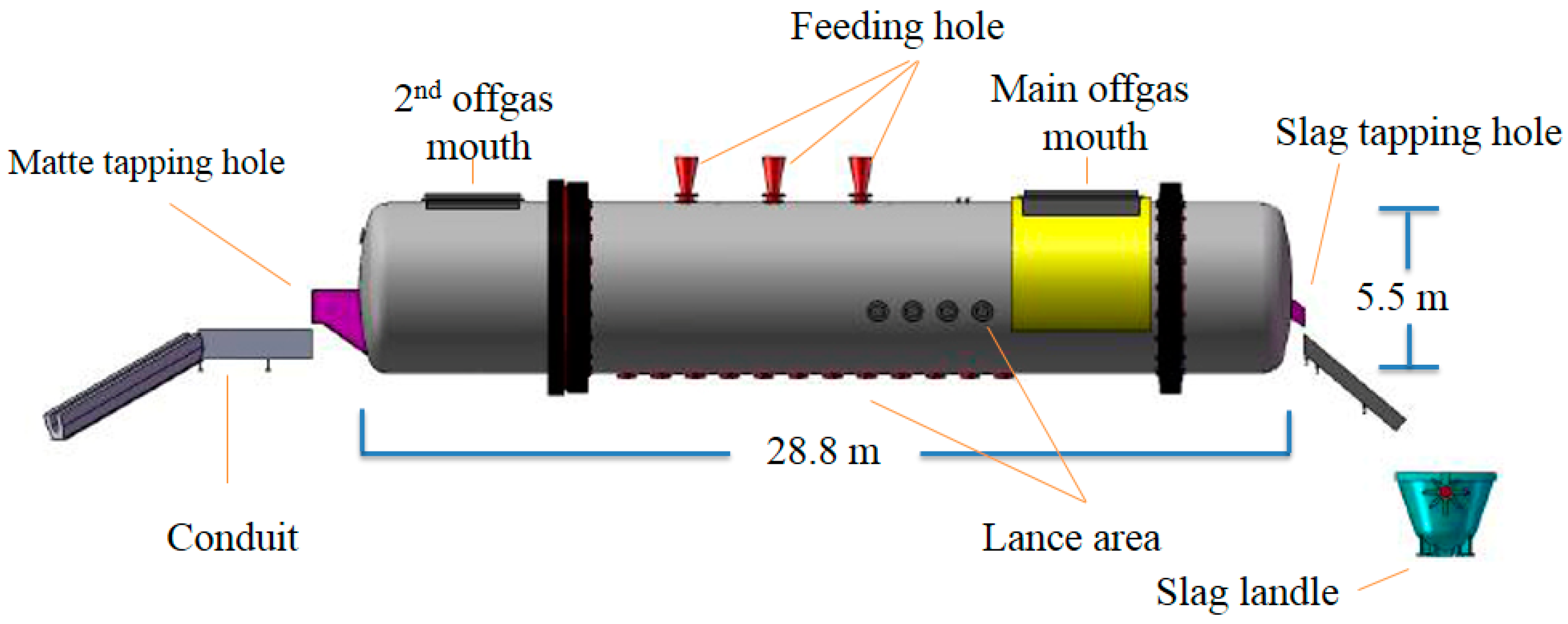
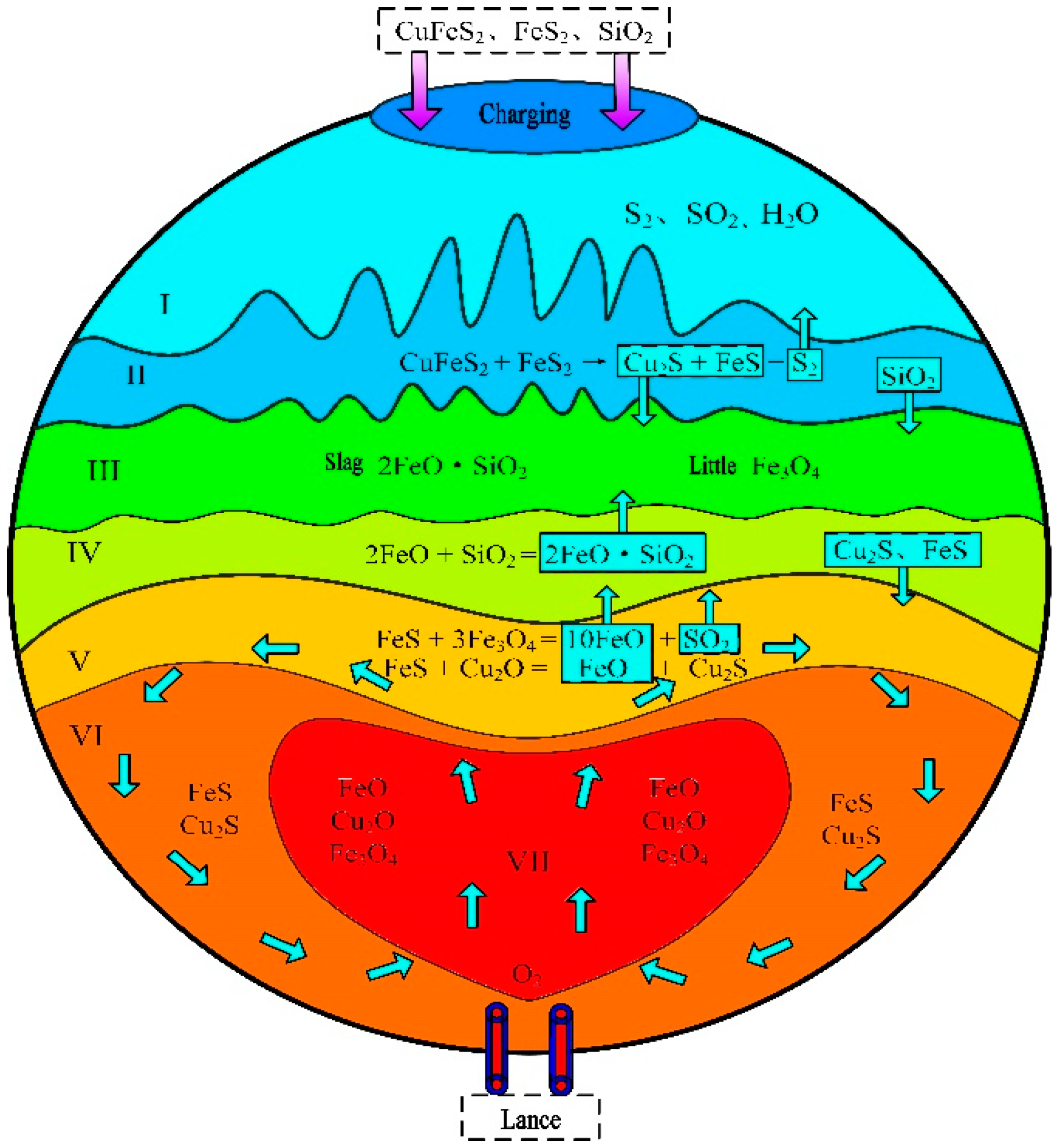
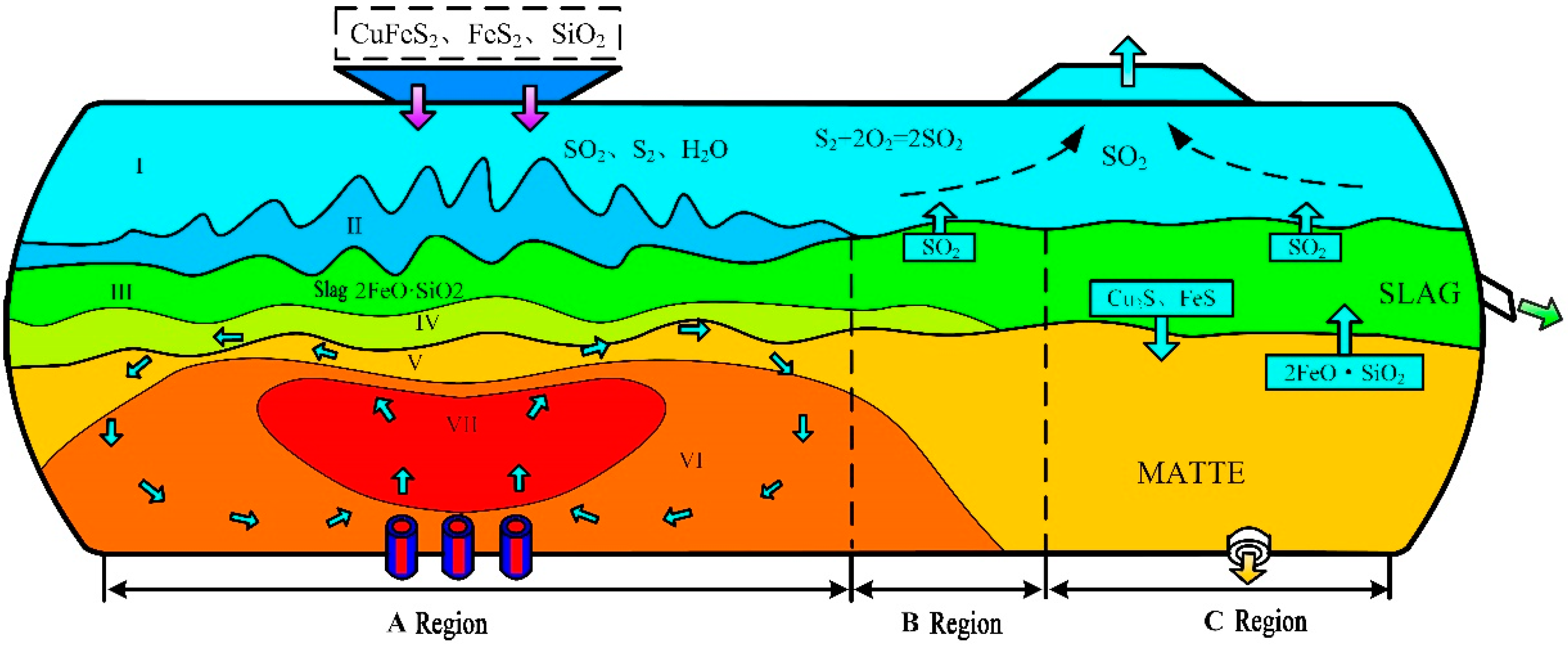
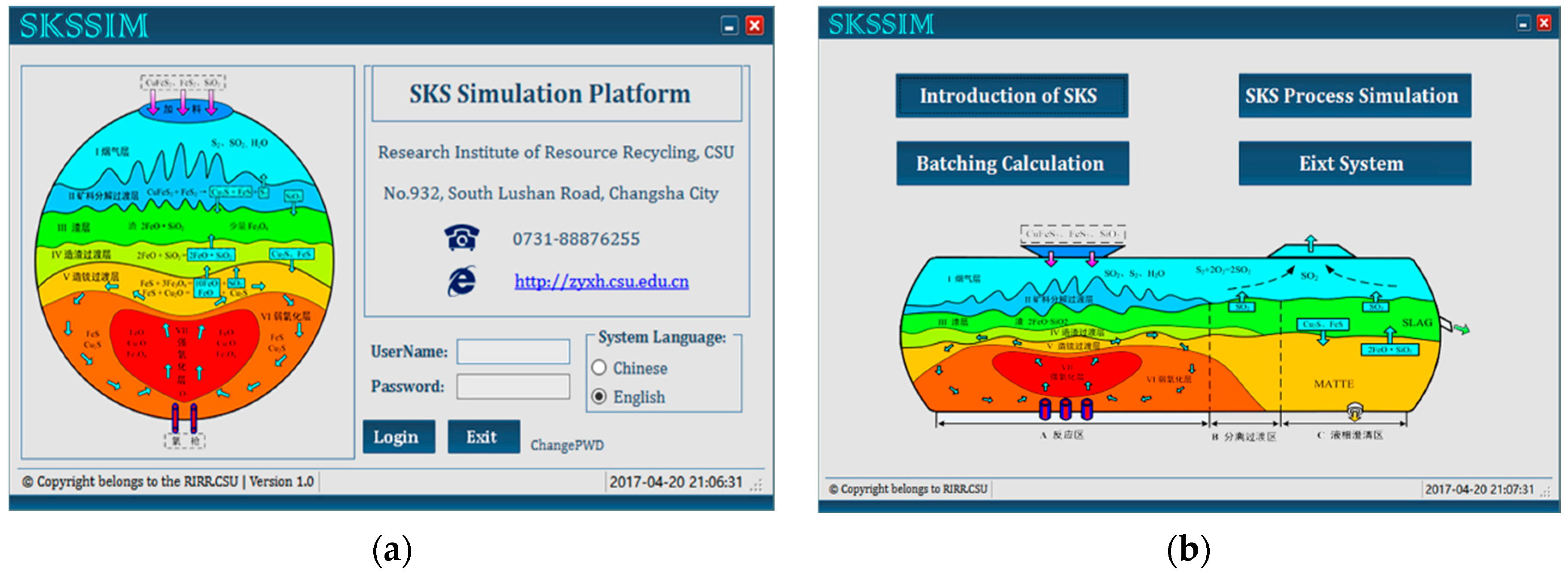
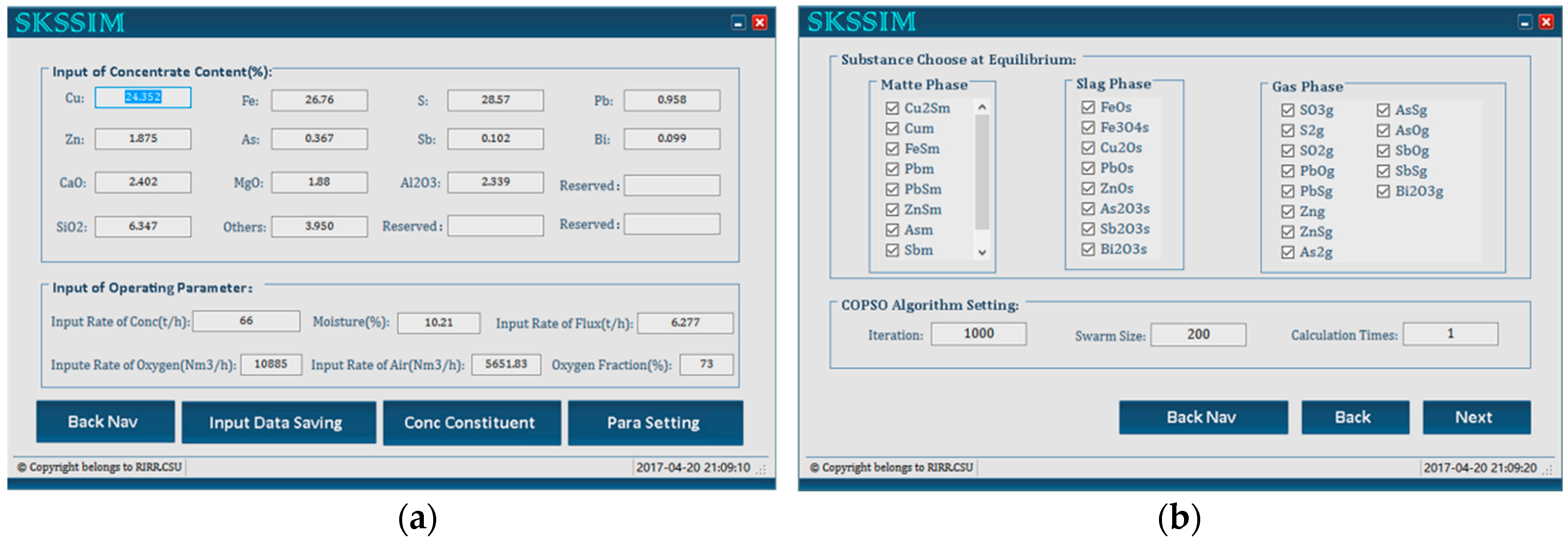

| Phases | Chemical Components |
|---|---|
| Gas | SO2, SO3, S2, O2, N2, H2O, PbO, PbS, Zn, ZnS, As2, AsO, AsS, SbO, SbS, BiS |
| Slag | FeO, Cu2S, Cu2O, Fe3O4, FeS, PbO, ZnO, As2O3, Sb2O3, Bi2O3, SiO2, CaO, MgO, Al2O3 |
| Matte | Cu2S, Cu, FeS, FeO, Fe3O4, Pb, PbS, ZnS, As, Sb, Bi |
| Components | Phase | Activity Coefficient |
|---|---|---|
| Cu2S | Matte | 1 |
| FeS | Matte | |
| Cu | Matte | 14 |
| FeO | Matte | |
| Fe3O4 | Matte | |
| Pb | Matte | 23 |
| PbS | Matte | |
| ZnS | Matte | |
| As | Matte | |
| Sb | Matte | |
| Bi | Matte | |
| FeO | Slag | |
| SiO2 | Slag | 2.1 |
| Fe3O4 | Slag | |
| Cu2O | Slag | |
| FeS | Slag | 70 |
| Cu2S | Slag | |
| PbO | Slag | |
| ZnO | Slag | |
| As2O3 | Slag | |
| Sb2O3 | Slag | |
| Bi2O3 | Slag |
| Components | State | ||
|---|---|---|---|
| Cu2S | liquid | −145,349 | 43.06 |
| FeS | liquid | −135,556 | 43.06 |
| PbS | liquid | −151,881 | 79.67 |
| ZnS | solid | −391,434 | 203.08 |
| Cu2O | liquid | −137,139 | 54.25 |
| FeO | liquid | −259,244 | 62.38 |
| Fe3O4 | solid | −1,097,693.74 | 305.93 |
| As2O3 | liquid | −1,215,325.18 | 457.37 |
| Sb2O3 | liquid | −687,438 | 237.86 |
| Bi2O3 | liquid | −563,470 | 257.66 |
| PbO | liquid | −196,818 | 79.15 |
| ZnO | solid | −475,260 | 208.63 |
| SiO2 | liquid | −912,677 | 180.92 |
| SO3 | gas | −459,543 | 165.15 |
| SO2 | gas | −361,500 | 72.49 |
| As2 | gas | −415,418 | 113.24 |
| AsS | gas | −184,465 | 45.88 |
| AsO | gas | −257,759 | 46.12 |
| SbO | gas | −126,601 | −60.35 |
| SbS | gas | 103,194 | −59.91 |
| BiS | gas | −0.057 | 96.74 |
| PbO | gas | 60,860 | −54.39 |
| PbS | gas | 57,812 | −53.83 |
| ZnS | gas | 13,200 | 32.15 |
| Matte Grade | Phase Entrainment Coefficient | |
|---|---|---|
| (%) | (%) | |
| 50 | 2.2 | 2.8 |
| 65 | 2.9 | 3.2 |
| 75 | 3.2 | 3.8 |
| Compositions | Cu | Fe | S | Pb | Zn | As | Sb | Bi | SiO2 | MgO | CaO | Al2O3 | Others |
|---|---|---|---|---|---|---|---|---|---|---|---|---|---|
| Content (wt %) | 24.4 | 26.8 | 28.6 | 0.96 | 1.9 | 0.37 | 0.10 | 0.10 | 6.4 | 1.9 | 2.4 | 2.3 | 3.9 |
| Operation Parameters | SKS Plant Data |
|---|---|
| Charging rate of dry mixed concentrates (t/h) | 66 |
| Water percent in the mixed concentrates (%) | 10.21 |
| Charging rate of flux (t/h) | 5.277 |
| Smelting temperature (K) | 1473 |
| Negative pressure in furnace (Pa) | 50–200 |
| Flowrate of pure oxygen (Nm3/h) | 10,885 |
| Flowrate of air (Nm3/h) | 5651 |
| Volume of O2 in oxygen-enriched air (%) | 73 |
| Matte grade (%) | 70 |
| Oxygen efficiency (%) | 99 |
| Compositions (wt %) | Cu | Fe | S | Pb | Zn | As | Sb | Bi | SiO2 | |
|---|---|---|---|---|---|---|---|---|---|---|
| Plant Data | matte | 70.77 | 5.52 | 20.22 | 1.73 | 1.07 | 0.07 | 0.04 | 0.06 | 0.51 |
| slag | 3.16 | 42.58 | 0.86 | 0.43 | 2.19 | 0.08 | 0.13 | 0.02 | 25.24 | |
| This Work | matte | 70.31 | 4.80 | 20.38 | 1.69 | 1.02 | 0.07 | 0.04 | 0.06 | 0.82 |
| slag | 2.93 | 42.07 | 0.73 | 0.37 | 2.08 | 0.07 | 0.12 | 0.02 | 25.18 | |
| Phases | Plant Data (%) | This Work (%) | ||||||||
|---|---|---|---|---|---|---|---|---|---|---|
| As | Sb | Bi | Pb | Zn | As | Sb | Bi | Pb | Zn | |
| Matte | 5.91 | 12.31 | 19.10 | 55.61 | 17.76 | 6.23 | 12.58 | 18.74 | 56.71 | 17.35 |
| Slag | 12.08 | 71.05 | 11.40 | 24.91 | 64.86 | 11.06 | 72.30 | 11.13 | 23.47 | 66.46 |
| Gas | 82.01 | 16.64 | 69.50 | 19.48 | 17.38 | 82.71 | 15.12 | 70.13 | 23.47 | 16.19 |
© 2017 by the authors. Licensee MDPI, Basel, Switzerland. This article is an open access article distributed under the terms and conditions of the Creative Commons Attribution (CC BY) license (http://creativecommons.org/licenses/by/4.0/).
Share and Cite
Wang, Q.; Guo, X.; Tian, Q.; Jiang, T.; Chen, M.; Zhao, B. Development and Application of SKSSIM Simulation Software for the Oxygen Bottom Blown Copper Smelting Process. Metals 2017, 7, 431. https://doi.org/10.3390/met7100431
Wang Q, Guo X, Tian Q, Jiang T, Chen M, Zhao B. Development and Application of SKSSIM Simulation Software for the Oxygen Bottom Blown Copper Smelting Process. Metals. 2017; 7(10):431. https://doi.org/10.3390/met7100431
Chicago/Turabian StyleWang, Qinmeng, Xueyi Guo, Qinghua Tian, Tao Jiang, Mao Chen, and Baojun Zhao. 2017. "Development and Application of SKSSIM Simulation Software for the Oxygen Bottom Blown Copper Smelting Process" Metals 7, no. 10: 431. https://doi.org/10.3390/met7100431





